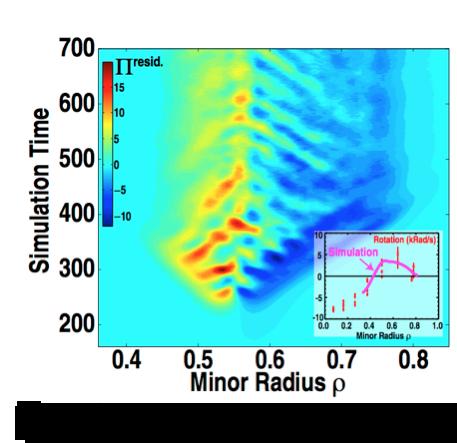Simulations of DIII-D experiments shed light on mysterious plasma flows

Simulation of plasma turbulence generating positive (red) and negative (blue) residual stress that drives rotation shear. (inset) Comparison between measured and simulated rotation profile. Credit: W. X. Wang
The results, reported in January in the journal Physical Review Letters, use first principles-based plasma turbulence simulations of experiments performed on the DIII-D National Fusion Facility that General Atomics operates for the DOE in San Diego.
The findings could lead to improved control of fusion reactions in ITER, the international experiment under construction in France to demonstrate the feasibility of fusion power. Support for this research comes from the DOE Office of Science with simulations performed at the National Energy Research Scientific Computing Center (NERSC), a DOE Office of Science User Facility at Lawrence Berkeley National Laboratory.
High energy beams
To enhance stability and confinement of the plasma, a gas composed of electrons and ions that is often called the fourth state of matter, physicists have traditionally injected high energy beams of neutral atoms. These energetic beams cause the core and outer region of the plasma to spin at different rates, creating a sheared flow, or rotation, that improves stability and confinement. One persistent mystery is how the plasma sometimes generates its own sheared flow, spontaneously.
The new research, led by PPPL physicists Brian Grierson and Weixing Wang, shows that sufficient heating of the core of the plasma generates a special type of turbulence that produces an intrinsic torque, or twisting force, that causes the plasma to generate its own sheared flow. The findings have relevance to large, future reactors, since neutral beam injection will create only limited rotation in the huge plasmas inside such facilities.
Self-organizing plasmas
The collaborative research by PPPL and General Atomics scientists found that plasmas can organize themselves to produce sheared rotation when heat is added in the right way. The process works like this:
- Heating the core of the plasma produces turbulence that fluctuates in strength along the radius of the gas.
- The fluctuations generate a “residual stress” that acts like a torque that causes the inner and outer parts of the plasma to rotate opposite to each other at different speeds.
- The different rotation speeds represent a balance between the turbulence-produced torque and the viscosity of the plasma, which keeps the gas from spinning arbitrarily fast.
Researchers used the GTS code to simulate the physics of turbulent plasma transport by modeling the behavior of plasma particles as they cycled around magnetic fields. The simulation predicted the rotation profile by modeling the intrinsic torque of the turbulence and the diffusion of its momentum. The predicted rotation agreed quite well, in shape and magnitude, with the rotation observed in DIII-D experiments.
A key next challenge will be to extrapolate the processes for ITER. Such modeling will require massive simulations that will push the limits of the high-performance supercomputers currently available. “With careful experiments and detailed simulations of fundamental physics, we are beginning to understand how the plasma creates its own sheared rotation,” said Grierson. “This is a key step along the road to optimizing the plasma flow to make fusion plasmas more stable, and operate with high efficiency.”
###
PPPL, on Princeton University's Forrestal Campus in Plainsboro, N.J., is devoted to creating new knowledge about the physics of plasmas — a gas composed of electrons and ions that is often called the fourth state of matter — and to developing practical solutions for the creation of fusion energy. The Laboratory is managed by the University for the U.S. Department of Energy's Office of Science, which is the largest single supporter of basic research in the physical sciences in the United States, and is working to address some of the most pressing challenges of our time. For more information, please visit science.energy.gov.
Media Contact
All latest news from the category: Physics and Astronomy
This area deals with the fundamental laws and building blocks of nature and how they interact, the properties and the behavior of matter, and research into space and time and their structures.
innovations-report provides in-depth reports and articles on subjects such as astrophysics, laser technologies, nuclear, quantum, particle and solid-state physics, nanotechnologies, planetary research and findings (Mars, Venus) and developments related to the Hubble Telescope.
Newest articles

Superradiant atoms could push the boundaries of how precisely time can be measured
Superradiant atoms can help us measure time more precisely than ever. In a new study, researchers from the University of Copenhagen present a new method for measuring the time interval,…

Ion thermoelectric conversion devices for near room temperature
The electrode sheet of the thermoelectric device consists of ionic hydrogel, which is sandwiched between the electrodes to form, and the Prussian blue on the electrode undergoes a redox reaction…

Zap Energy achieves 37-million-degree temperatures in a compact device
New publication reports record electron temperatures for a small-scale, sheared-flow-stabilized Z-pinch fusion device. In the nine decades since humans first produced fusion reactions, only a few fusion technologies have demonstrated…





















